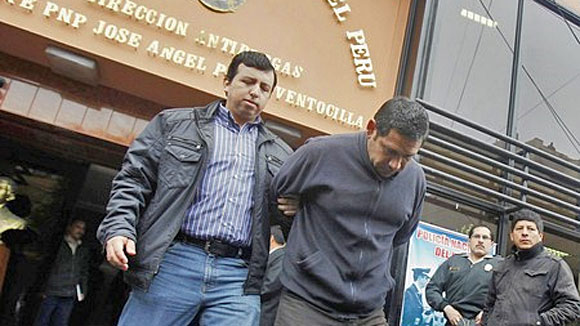
(above) An anti-narcotics officer escorts a detained suspected Colombian drug trafficker at a police station in Lima, Peru. (Enrique Castro-Mendivil, Reuters / August 18, 2011)
Peru suspends coca eradication program
August 18, 2011 - Los Angeles Times
The move comes as a surprise to the U.S., whose envoy says she is awaiting an explanation from the Peru government over the halting of the program that targeted coca, the base material of cocaine.
By Adriana Leon and Chris Kraul, Los Angeles Times
Reporting from Lima, Peru, and Los Angeles--
Peru's new government has suspended the nation's only coca eradication program, to the surprise of an envoy from the United States, which finances the anti-narcotics program.
Ricardo Soberon, new chief of the National Commission for the Development of Life Without Drugs, said Wednesday that the temporary suspension was ordered so the government could "evaluate the policies." Similar suspensions have taken place in Colombia and Afghanistan, where U.S.-backed eradication programs are in progress, he said.
Soberon also told reporters that the government of leftist President Ollanta Humala, who was elected in June, is in the process of negotiating antidrug agreements with the U.S. He said that past counter-narcotics policies have failed, leading to a rise in the cultivation of coca, the base material of cocaine.
U.S. Ambassador Rose M. Likins told reporters as she left the National Assembly building in Lima that she was awaiting an explanation of the government's reasons for the suspension of the manual eradication program, which began in January in the Upper Huallaga Valley region. The U.S. has spent $10 million on the effort this year.
"We are waiting for some communication from the government about the suspension of the coca eradication program," Likins said. The ambassador said she would have appreciated notice, though she understood that a change of government often brings new policies.
"We are in Peru and are working with the authorities," she said.
The suspension was ordered Tuesday by Interior Minister Oscar Valdes, who in a statement Wednesday reiterated Humala's commitment to reducing coca cultivation. He said the suspension was implemented to "complete evaluations and reorient means" with the goal of devising the most effective antidrug policy.
According to the United Nations Office on Drugs and Crime annual report issued in June, Peru ranks a close second to Colombia among the world's leading coca and cocaine producers. Huallaga Valley is not the country's chief coca growing region. That distinction belongs to the area known as VRAE, the Spanish acronym for the Apurimac Ene River Valley, an area so lawless that the eradication programs are thought to be impractical from a security standpoint.
Humala has sent mixed signals on his commitment to reducing coca crops. At the close of his campaign in May, he promised an audience in the Huallaga Valley town of Tingo Maria, which included people who have been agitating for the right to grow coca because they lack other economic alternatives, that he would reevaluate the government's eradication program in the area.
The program involves about 900 workers in the valley, which is about 180 miles northeast of Lima, the capital. The area is believed to still have about 5,000 acres of coca crops, a small fraction of the 130,000 acres of coca in Peru at the beginning of the year. About 15,000 acres have already been uprooted by workers.
Unlike Colombia, Peru does not permit aerial fumigation of coca, citing health and safety concerns.
Former Interior Minister Fernando Rospigliosi told journalists Wednesday that the suspension goes against Humala's promises to fight drug trafficking.
"On July 28, [Humala] said he was going to continue with eradication and then yesterday personally gave the order to the interior minister to suspend it," Rospigliosi said.
Special correspondents Leon reported from Lima and Kraul from Los Angeles.